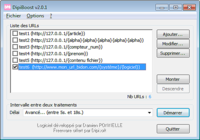
- KON BOOT 2.3 USB HOW TO EASILY INSTALL
- KON BOOT 2.3 USB FOR WINDOWS 10 IS PRESENT
- KON BOOT 2.3 USB RAR TAILLE DU
Kon Boot 2.3 Usb Rar Taille Du
Kon Boot 2.3 Usb How To Easily Install
Universal USB Installer aka UUI is a Live Linux Bootable USB Creator. This week, in a fit of ruthless efficiency, I discovered that it's possible to do without the USB stick: I can plug my phone into a computer, and boot directly from it.Universal USB Installer Easy as 1 2 3. Kon-Boot is a handy tool to have when you forget your password to your Windows.Two of the things I carry with me everywhere are a USB stick containing a live Linux installation (so that I can boot Windows machines into Linux and get to my own desktop and files), and my phone. (Kon-Boot isnt free anymore) In this step-by-step tutorial i will show you how to easily install Kon-Boot on your USB. Kon-Boot permet d’acc&233 der en toute simplicit&233 &224 une. Article nom: Kon boot 2 0 usb H&233 berg&233 par: mega.co.nz Type de fichier: rar Taille du fichier: 454.84 MB Desc: En effet, le live-CD Kon-Boot telecharger kon boot 2 0 usb qui peut aussi &234 tre embarqu&233 sur cl&233 USB, sattaque au kernel noyau d&232 s la phase de boot d&233 marrage pour contourner temporairement le syst&232 me d.
Kon Boot 2.3 Usb For Windows 10 Is Present
Unfortunately, CDs are hard to put in your pocket, and many machines dont have floppies any more. Kon-Boot will converts the contents of the Windows kernel while booting, bypassing authorization system and allow Windows to enter a password protected user account without using a password.Kon-Boot is sort of a boot loader that lets you bypass having to use valid credentials when the OS finishes booting. Note: SecureBoot bypass and online/live password bypass for Windows 10 is present only in COMMERCIAL LICENSES (UEFI mode only Windows 10 x64).My wife's Windoze laptop, booted into Fedora using my phoneKon Boot 2.3 Windows 10 32Bit 64Bit Download Kon-Boot 2.5 Kon-Boot is a powerfull windows bypass administrator password that allows you to login into protected computer without knowing password. Kon-boot can be installed by using the original installer only. One kon-boot license permits the user to install kon-boot on only one USB pendrive. The software is easy to use Simply.
Prepare a Fedora ISO image that you'd like to boot from. For bonus marks, you can set your phone up to read the encrypted image and get access to your documents directly from your phone.Here's what to do to get your phone set up for booting. Effectively you can carry your computer round in your pocket, with all the programs you want, and all your documents safely encrypted. Format it, partition it, boot off it.That opens up a world of possibilities. That means that you can do pretty much anything to it that you could do if it were a USB stick.
You don't need to repartition: this can all go on the FAT32-formatted partition you already have. To play this game properly, you'll need enough space for the installation image (~650MB for the live CD), some space for a persistent overlay so that you can install and remove other programs and edit system settings (~350MB should be plenty), and some space for an encrypted filesystem containing your documents so maybe 1GB plus document storage space. Make sure there's enough room on your phone's SD card.
Now boot your computer from your phone! Set your phone to 'Disk drive' mode again, reboot your computer, and hit F12 or whatever lets you choose a boot device, and select 'USB device' or equivalent.I've found that it is a little slow when booting up, but operates at a fair old lick when running. Reboot your phone to convince yourself you didn't brick it. The '-reset-mbr' isn't as scary as it looks: it doesn't destroy the partition table, but it does set the master boot record to something that you can boot from. I'm using Fedora, so the gubbins I need to perform the installation is already there, in the livecd-tools package the command I use to install onto a USB stick isLivecd-iso-to-disk -reset-mbr -overlay-size-mb 350 -home-size-mb 1024 whatever.iso /dev/sdb1Be very careful to get this right! You need to replace '/dev/sdb1' with the device representing your card's FAT32 partition. Plug your phone into your computer, put it in 'Disk drive' mode, and then use parted on Linux, or a GParted live CD, or whatever you Windows types use for partition management. Set the FAT32 partition on your phone's SD card to be bootable.
On the other hand, if you have rooted your phone, you'll be able to access the encrypted files directly from your phone. All you're doing is using it to store some files. Do I need to have rooted my phone? No. I even compiled a kernel and it coped just fine.Answers to questions for more excitable types: For web browsing, editing OpenOffice documents, programming and pretty much anything, it works very nicely.
If you've used an A2SD-style separate partition, your apps will all work fine.) (That does mean that your FAT32 partition won't be mounted on your phone, so any apps that you've got stored on the SD card using the native Froyo system won't be operational. There's nothing to stop you using your phone as a phone, as long as you don't unplug it, reboot it or turn it off 'Disk drive' mode. What do I do if the phone rings? Answer it. On my phone, at least, the USB port supplies more than enough power to keep it operating as a disk drive, so it'll charge up rather than drain.

Here's the rough outline of what to do to open the image, and how to change the encryption if necessary. The fourth is the trickiest, but not impossible and by far the easiest approach is to change the encryption to match your kernel rather than change your kernel to match the encryption. a phone kernel with compiled-in support for the encryption present in the encrypted partition.If you don't already have the first, you probably shouldn't be messing with this low-level stuff. a recent busybox binary (if you haven't got it already, install from the Market or download) a cryptsetup binary compiled for ARM ( download)

Try to open it: cryptsetup luksOpen /dev/loopx enchome Map the device: busybox losetup /dev/loopx /sdcard/LiveOS/home.img Anything numbered from 4 upwards works fine for me. Check that the one you've created is still free! It should be, but for some reason, when I create /dev/loop0 through to /dev/loop3 on my phone, they all get eaten straight away.
Make sure you stick to something that gives you a decent level of security. A look at /proc/crypto will give you some clues as to what's available, but it's not easy to work out exactly what it all means. You could try 'aes-cbc-plain' or just 'aes' or even 'twofish'. If you've stored anything important in the encrypted image, stop and copy it out, because this will destroy it (but you only have to do it once):Cryptsetup -cipher=aes-cbc-benbi luksFormat /dev/loopxYou might need to try different cipher specs till you find one that your kernel supports. If you get an error telling you to check your kernel for the right cipher support, it means you're going to need to change the encryption.
Make an empty directory somewhere that you can mount it in (say, /sdcard/encimage), and then mount it with: mount /dev/mapper/enchome /sdcard/encimageFrom now on, you should be able to follow this procedure (without needing to change the encryption every time) to mount the image with full read/write access. Once you've successfully run the luksOpen command, you can now mount the image. You'll now need to format it again, with busybox mke2fs -m 0 /dev/mapper/enchomeIf you get an 'applet not found' error, your version of busybox isn't recent enough.
It could be solved if I can find an app that just leaves the sdcard mounted as a usb device by default, rather than automatically unmounting and mounting as soon as it's plugged in/out.It's the same on my laptop and my desktop.However my desktop running Ubuntu Lucid Lynx when fully booted and logged in, when I connect my phone via USB it adds and mounts the image on the sdcard as a live cd that I can run inside of the desktop. It's an annoying situation because if it only did it just under a second quicker, I think it would recognize it.It just must be an issue with the milestone. It did, however as soon as you leave the bios the computer restarts, and immediately the sdcard unmounts and then tries to remount again as it boots back. Booting into the bios to see if that would delay long enough for the sdcard to mount. I'm working on it.All computers I tested on can boot from usb and is set to check usb first in the bios.I tried that last night.
However, to get it to boot, have you tried using the boot chooser (or boot menu?) Most computers have an option to pull up a boot menu outside of the bios menu to be able to select exactly which device to read from. The external SDCard should be able to be run from, like you are trying, while the internal is probably best to leave alone, but you could in reality run from it as well (like James said, this is a non-destructive process, so. :) Reply DeleteI just saw this thread, sorry I'm a little late to the game, but I should be able to clear up a couple of questions - first, - I believe the HTC Incredible has two memories, plus the internal firmware. I can still run the linux live "cd" inside the host OS.I just can't get it to run at boot up which is the entire point.If I can solve this I'll post what I done here so other users with the same model/issue have this problem can see what I have done.Thanks for the reply man and if you can think of anything let me know.


 0 kommentar(er)
0 kommentar(er)
